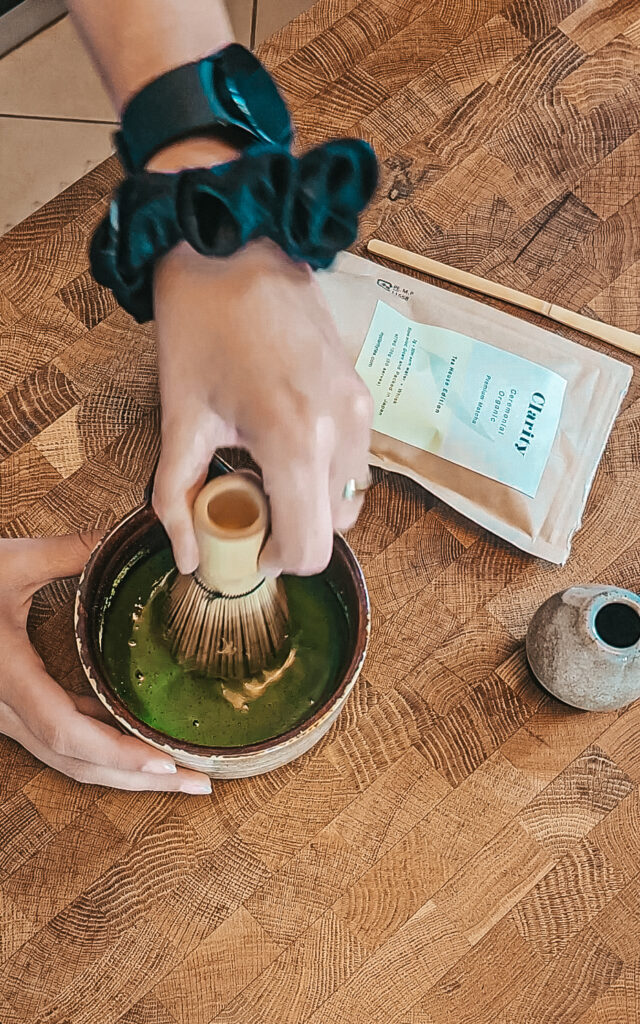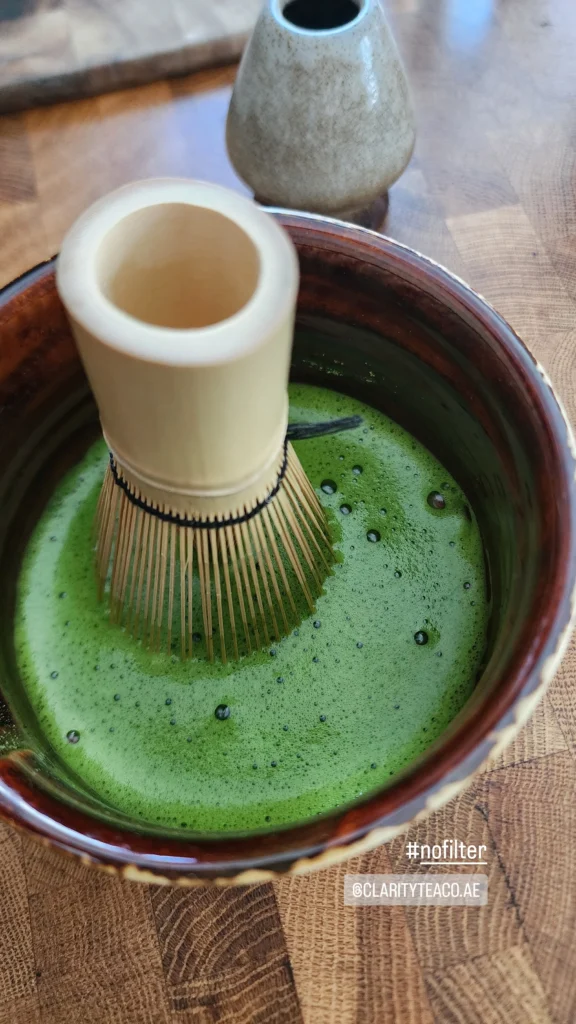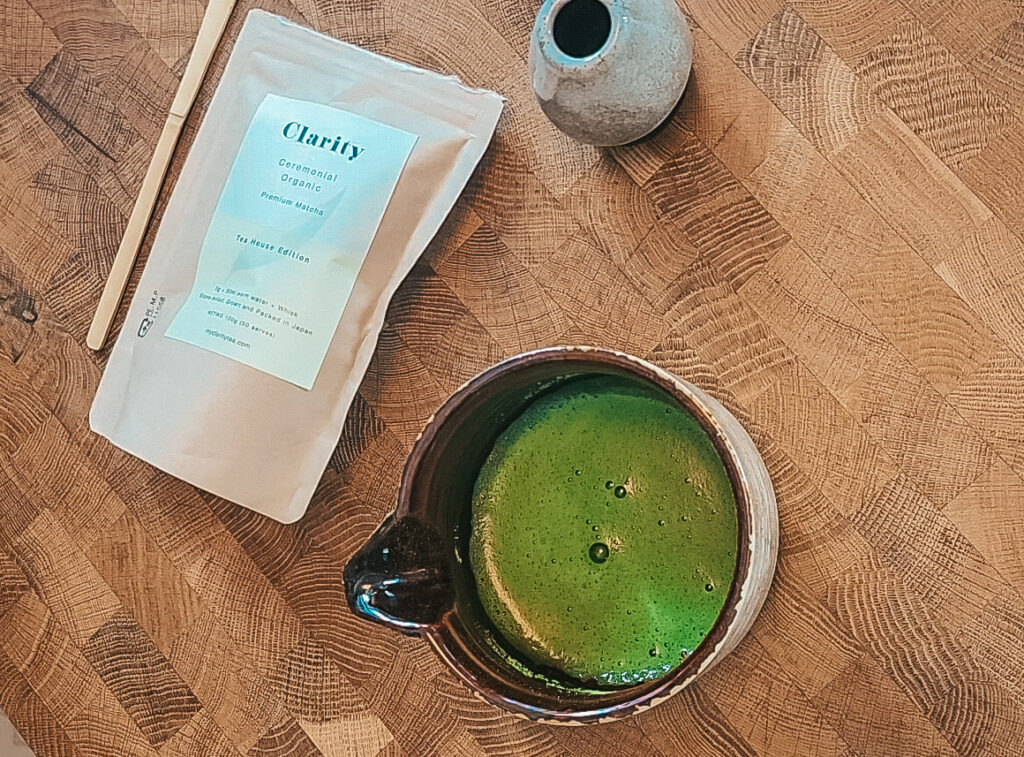
A guide to Matcha Tea for those of us who seek an alternative to coffee. Matcha tea offers a refreshing and invigorating option. It is known as “green gold,” matcha is a fine powder made from specially grown and processed green tea leaves. This vibrant tea not only provides a significant energy boost, but also boasts a rich history and diverse applications that make it a favorite among tea enthusiasts worldwide. So, let’s dive into the world of matcha and explore what makes it such a remarkable brew.
Discovering the Origins of Matcha
Matcha’s history is deeply intertwined with Japanese culture. Although the practice of grinding tea into powder originated in China, it was in Japan that matcha flourished and became an integral part of the traditional tea ceremony. The process of cultivating matcha is unique: the tea bushes are shaded for about three weeks before harvest to enhance the chlorophyll content and amino acids, which contribute to its distinctive flavor profile and vibrant, jade-green color.
After harvesting, the leaves, that are known as tencha, are steamed, dried, and deveined before being stone-ground into the fine powder we know as matcha. This meticulous process is key to preserving the tea’s nutritional benefits and unique taste characteristics.
Quality Matters: Grading Matcha
The first thing to understand and the most important detail in a guide to Matcha Tea. The quality of matcha can significantly impact your drinking experience. Matcha is typically graded into three categories: ceremonial, premium, and culinary. Understanding these distinctions will help you choose the right type for your needs.
- Ceremonial Grade: Is the highest quality available, ceremonial grade matcha and is intended for traditional tea ceremonies and meant to be consumed on its own. Its vibrant color and delicate flavor, with subtle sweetness and umami, make it the gold standard for matcha enthusiasts. Drinking ceremonial grade matcha pure allows its finest qualities to shine.
- Premium Grade: A step below ceremonial, premium grade matcha is still a high-quality option suitable for everyday consumption. It boasts a slightly more robust flavor, making it versatile enough to mix with other ingredients while still retaining the essential character of matcha.
- Culinary Grade: This grade is designed for use in cooking and baking. While not as smooth or sweet as the higher grades, it provides an excellent matcha flavor for recipes such as smoothies, lattes, and desserts. It’s the most cost-effective option for incorporating matcha into your culinary adventures.


The Energy Boost of Matcha
Unlike coffee, which delivers a quick spike of energy followed by a crash, matcha offers a more sustained energy release. This is partly due to the presence of L-theanine, an amino acid that promotes relaxation without drowsiness. L-theanine, combined with caffeine, results in a calm yet alert state that enhances concentration and focus. For those who prefer not to drink coffee, matcha serves as a superb alternative, providing increased energy levels without the jittery side effects.
Enjoying Matcha: Pure and Mixed Delights
For me, matcha tea is a versatile beverage that adapts to the occasion. When savoring a high-quality ceremonial grade matcha, I prefer to drink it pure. The ritual of whisking the powder with hot water into a frothy, emerald-green infusion is a calming experience that heightens my appreciation for its nuanced flavors, and during the hot months in Dubai, I will go for an Iced Matcha, just pouring it over ice for the refreshing drink.
On other occasions, I enjoy experimenting with matcha blends. One of my favorite concoctions involves mixing matcha with fresh watermelon juice—an unexpected pairing that transforms the tea into a refreshing, hydrating summer beverage. The sweetness of the watermelon complements the earthy notes of matcha, creating a harmonious blend that’s both revitalizing and delicious.
For a zesty twist, try combining matcha with lime and honey. The tang from the lime, balanced with honey’s natural sweetness, adds a bright, invigorating edge to the matcha. This combination not only tastes great but also enhances the health benefits, as both lime and honey are known for their immunity-boosting properties. I can expand this guide to Matcha Tea to include my favorite recipes, let me know in the comments.
Matcha in Wellness and Everyday Life
Matcha is renowned not only for its energizing properties but also for its myriad of health benefits. Rich in antioxidants, particularly catechins, matcha supports the immune system, helps detoxify the body, and offers protection against various diseases. Regular consumption of matcha is associated with improved cardiovascular health, weight management, and even a reduced risk of chronic illnesses.
Adding matcha to your daily routine is simple. For those leading a busy lifestyle, matcha makes a quick and easy-to-prepare beverage that fits seamlessly into your morning ritual. Whisking up a cup takes only minutes and provides sustained energy throughout the day. Alternatively, incorporating matcha into recipes—from smoothie bowls and overnight oats to baked goods and energy bars—can add a nutritious boost to your meals.
I personally like to take a couple of extra minutes to complete the full ritual of whisking it with the bamboo whisk, but it works well with the handheld electric milk-frother also, and might be a practical alternative.
Choosing Your Matcha
When selecting matcha, consider both quality and origin. You should look for a reputable source that offers detailed information about their matcha, including where it’s grown and how it’s processed. Authentic matcha is primarily produced in Japan, particularly in regions like Uji, Nishio, and Shizuoka, which are renowned for their superior tea-growing climates. Prioritizing Japanese matcha, which is often organic and carefully crafted, can ensure that you’re getting the most authentic and high-quality product available.
Examine the color and smell of the matcha as indicators of its quality. High-grade matcha should be a vibrant, deep green indicative of rich chlorophyll content. The aroma should be fresh and slightly grassy, with no hints of bitterness or a stale smell.
If you are located in Dubai or in the UAE, I highly recommend the Clarity Tea or Avantcha Tea, I love both, but Clarity Tea has my heart, the quality is from another world and the service is the best.
Embracing the Matcha Ritual
The process of preparing matcha can be as rewarding as drinking it. Embracing the matcha ritual offers a quiet moment of mindfulness amid the hustle and bustle of daily life. Traditionally, matcha is made using a small bamboo whisk called a chasen, a tea scoop, and a bowl, known as a chawan. The ritual begins with sifting the matcha to remove any clumps, followed by adding hot water and whisking in a zigzag motion until the tea is frothy and smooth.
Participating in this time-honored tradition not only heightens your appreciation for matcha’s taste but also invites you to pause, reflect, and enjoy a meditative moment. Whether shared with friends or enjoyed alone, the matcha ritual creates an intentional space for calm and presence, enhancing your connection to this remarkable tea.
The Global Influence of Matcha
While deeply rooted in Japanese culture, matcha has gained popularity worldwide as a versatile ingredient in both traditional and contemporary cuisine. From trendy matcha lattes in Western cafes to matcha-infused sweets in Asian markets, this green powder has woven itself into the culinary fabric across cultures. Its adaptability, combined with a distinct flavor and impressive health benefits, make matcha a beloved staple for many.
As matcha continues to captivate a global audience, the opportunities for innovation and experimentation flourish. Chefs and home cooks alike are exploring new ways to incorporate matcha into everyday dishes, creating delicious combinations that honor both tradition and modern tastes.
A Versatile Companion to Your Wellness Journey
Matcha tea is more than just a source of energy; it’s a versatile and healthful companion to anyone’s wellness journey. Whether you’re drawn to its rich historical roots, its mindfulness-inducing ritual, or its array of health benefits, matcha offers an inviting and invigorating experience that can transform your day.
For those seeking an alternative to coffee or looking to enhance their tea-drinking repertoire, matcha provides an exciting and energizing option. Whether enjoyed pure or experimented with in creative blends, matcha connects us to nature, culture, and self-awareness—a truly remarkable brew that stands in a class of its own.
From the vibrant hillsides of Japan to tea lovers around the globe, matcha invites you to explore and delight in its complex flavors and soothing energy. As you incorporate this green gold into your life, may it bring you the same joy, focus, and vitality that it has brought to countless generations before.





Leave a Reply